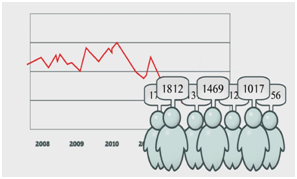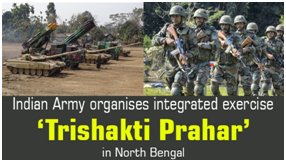ECONOMIC DEVELOPMENTS
1. WHAT IS A CIRCUIT BREAKER IN TRADING?
TAGS: PRELIMS PERSPECTIVE- GS-III-ECONOMY
Recently after the Hindenburg revelations, many of the Adani Group companies’ stocks have hit the lower circuits in subsequent trading sessions.
About Circuit breaker:
- The Securities and Exchange Board of India (SEBI) implemented index-based market-wide circuit breakers in June 2001.
- Circuit breakers are triggered to prevent markets from crashing due to a panic-induced sale of stocks.
- This can occur for a variety of reasons, leading to stockholders in the market believing that their stocks are overvalued. As a result, they engage in a sell-off.
- Circuit breakers temporarily halt trading, thereby halting the sell-off.
- Circuit-breakers effectively limit how much a stock’s value can fall in a single day/trading session, resulting in a more stable market overall.
How do these work?
- This index-based market-wide circuit breaker system applies at three stages of the index movement, at 10, 15 and 20 per cent.
- When triggered, these circuit breakers bring about a coordinated trading halt in all equity and equity derivative markets nationwide.
Criticism of Circuit Breakers
- Some analysts believe that circuit breakers are disruptive and keep the market artificially volatile because they cause orders to build at the limit level and decrease liquidity.
- Critics of circuit breakers argue that if the market were allowed to move freely, without any halts, they would settle into a more consistent equilibrium.
2. SENIOR CITIZEN SAVINGS SCHEME (SCSS)
TAGS: PRELIMS PERSPECTIVE- GS-III-ECONOMY
THE CONTEXT: The maximum investment limit for the Senior Citizen Savings Scheme (SCSS) has been increased from Rs 15 lakh to Rs 30 lakh in Budget 2023.
THE EXPLANATION:
About Senior Citizen Savings Scheme (SCSS):
- SCSS was launched with the main aim of providing senior citizens in India a regular income after they attain the age of 60 years old.
Who is eligible?
- Indian citizens above the age of 60 years.
- Retirees in the age bracket of 55-60 years who have opted for Voluntary Retirement Scheme (VRS) or Superannuation.
- Retired defence personnel above 50 years and below 60 years of age.
- Maturity: It has a maturity period of five years. But, a depositor can extend one’s maturity period for another three years.
- Number of accounts: Individuals are allowed to operate more than one account by themselves or open a joint account with their spouse.
- Deposit Limits: Eligible investors can make a lump sum deposit
- Minimum Deposit– Rs. 1,000 (and in multiples thereof)
- Maximum Deposit– Rs. 15 Lakh or the amount received on retirement, whichever is lower(Increased to Rs 30 lakh in Budget 2023).
- Interest Payment: Under SCSS, the interest amount is paid to the accountholders quarterly.
- Premature withdrawal: After one year of opening the account, premature withdrawal is allowed.
- Deposits in SCSS qualify for deduction u/s 80-C of Income Tax Act.
3. WHAT IS EXPORT-IMPORT BANK OF INDIA (EXIM BANK)?
TAGS: PRELIMS PERSPECTIVE- GS-III-ECONOMY
THE CONTEXT: Union Finance Minister recently announced the setting up of a subsidiary of EXIM Bank and data embassies at GIFT City in Gujarat.
THE EXPLANATION:
About EXIM Bank:
- It is the premier export finance institution of the country.
- It was established by the Government of India, under the Export-Import Bank of India Act, 1981
- EXIM Bank wholly owned by the Government of India.
Services:
- EXIM Bank provides financial assistance to exporters and importers.
- It extends Lines of Credit (LOCs) to overseas financial institutions, regional development banks, sovereign governments and other entities overseas, to enable buyers in those countries to import developmental and infrastructure projects, equipment, goods and services from India, on deferred credit terms.
- It functions as the principal financial institution for coordinating the work of institutions engaged in financing export and import of goods and services with a view to promoting the country’s international trade.
Structure:
- The operations of the Bank are governed by a Board of Directors.
- The Board of Directors consists of a chairman, a managing director, two deputy managing directors; one director each nominated by the Reserve Bank of India; IDBI Bank Ltd. and ECGC Ltd.; and not more than 12 directors nominated by the Central Government.
VALUE ADDITION:
Gujarat International Finance Tec-City (GIFT City):
- Location: It is located in the state of Gujarat, between Ahmedabad and Gandhinagar, on the bank of river Sabarmati.
- The GIFT city is built on 886 acres and has a multi-service Special Economic Zone (SEZ).
- It is home to India’s first International Financial Services Centre(IFSC) and also has Domestic Tariff Area (DTA)
- It aims to be a ‘smart city’ for India’s growing finance and technology sectors.
- It is being developed as a well-planned and technology-enabled smart city having world-class commercial, residential and social facilities of global standards.
4. WHAT IS URBAN INFRASTRUCTURE DEVELOPMENT FUND (UIDF)?
TAGS: PRELIMS PERSPECTIVE- GS-III-ECONOMY
THE CONTEXT: Finance Minister recently announced that government will set up an Urban Infrastructure Development Fund (UIDF) of Rs 10,000 crore per year for creating infrastructure in Tier-2 and Tier-3 cities.
THE EXPLANATION:
About Urban Infrastructure Development Fund (UIDF):
- UIDF will be established through the use of priority sector lending shortfall.
- Purpose: The fund will be used by public agencies to create urban infrastructure in tier-2 and tier-3 cities.
- It will be managed by the National Housing Bank.
- It will be established on the lines of the Rural Infrastructure Development Fund (RIDF).
- States will be encouraged to leverage resources from the grants of the 15th Finance Commission, as well as existing schemes, to adopt appropriate user charges while accessing the UIDF.
What are tier-2 and tier-3 cities?
- Cities with a population in the range of 50,000 to 100,000 are classified as tier 2 cities, while those with a population of 20,000 to 50,000 are classified as tier 3 cities.
What is Rural Infrastructure Development Fund (RIDF)?
- The RIDF was set up by the Government in 1995-96 for financing ongoing rural Infrastructure projects.
- The Fund is maintained by the National Bank for Agriculture and Rural Development (NABARD).
- Contribution: Domestic commercial banks contribute to the Fund to the extent of their shortfall in stipulated priority sector lending to agriculture.
- Main Objective: To provide loans to State Governments and State-owned corporations to enable them to complete ongoing rural infrastructure projects.
- Repayment period: Loan to be repaid in equal annual instalments within seven years from the date of withdrawal, including a grace period of two years.
PRELIMS PERSPECTIVE
5. INDIAN MILITARY JOINT TRAINING EXERCISE TRISHAKTI PRAHAR
TAGS: PRELIMS PERSPECTIVE
THE CONTEXT: The Indian Defense Forces conducted firepower exercises called the “TRISHAKTI PRAHAR” to synergize the firepower assets and to orchestrate a battle. The exercise is important to keep the forces ready for battle. The exercise was conducted by the Indian Air Force, CAPF, and the Indian Army. It was a firepower exercise.
THE EXPLANATION:
About Trishakti Prahar
- The main objective of Trishakti Prahar was to refresh battling skills
- All the latest defense equipment was used during the exercise. This includes helicopters, infantry combat vehicles, new-generation equipment, mortars, artillery guns, etc.
- Equipment made as a part of AtmaNirbhar Bharat Abhiyan was also used in the exercise
- Forces moved and rehearsed across the regions of North Bengal
- The Indian Army checks if the troops are in battle preparedness through these exercises
- Reviewed by Eastern Command
- The eastern command officer Lt Gen RP Kaltia reviewed the exercise. The eastern command is based in Kolkata and is one of the six commands of the Indian Army.
Where was the exercise held?
- Teesta Field Firing Ranges. It is near Siliguri. The Siliguri is strategically important to India. This narrow 20 to 30-km-wide passage touches Bangladesh in the south and Bhutan in the north. If this passage is closed, the Indian mainland will lose its contact with the northeastern states. For this reason, the Siliguri corridor is important to India.

